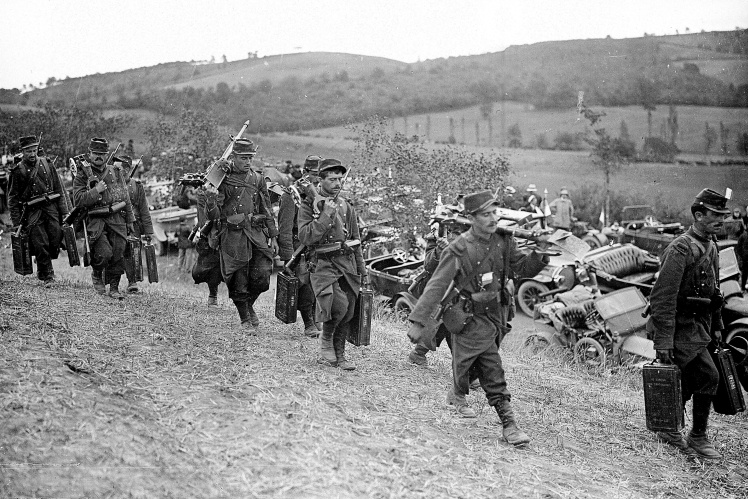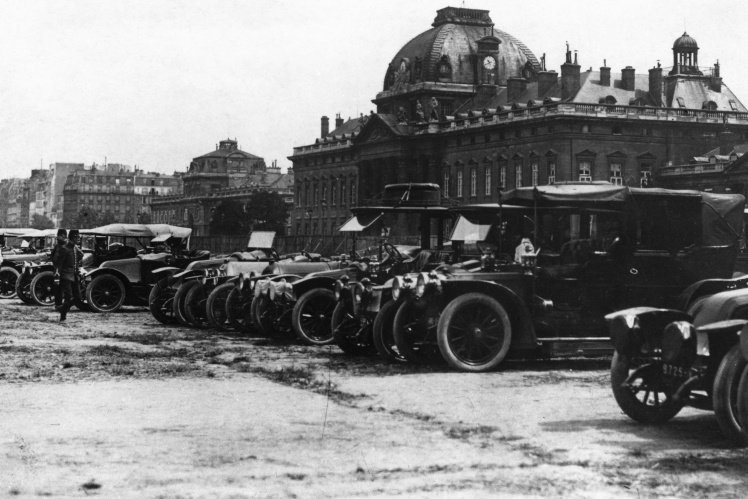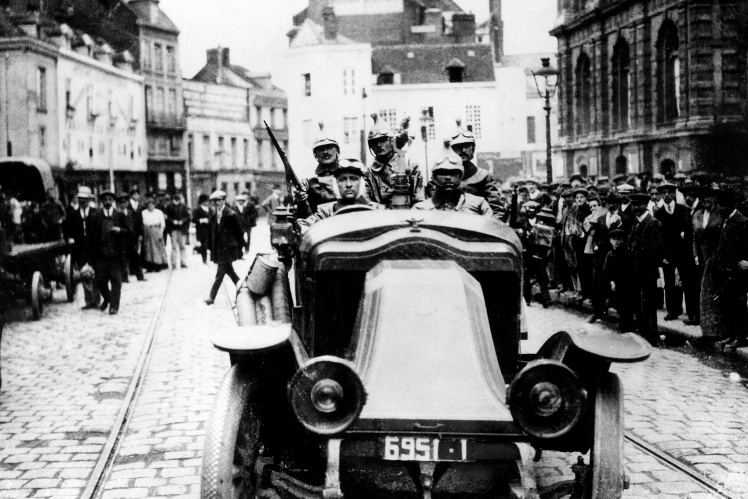How the Taxi Saved Paris
At the beginning of the 20th century, the pioneers of the French automotive industry, the Renault brothers, released a new Renault Type AG car model. The novelty began to be used as a taxi. In 1905, the fleet of Paris taxis had about 1 500 cars of this model. The Renault Type AG became so popular that it was exported to Great Britain, the United States, and Argentina.
In 1914, the World War I began. During August, the Germans pushed the Franco-British troops deep into France. At the beginning of September, the French had to throw their main forces into the defense of the capital. On September 5, 1914, a battle began between French and German troops on the Marne River, about 40 kilometers from Paris.
Soldiers who arrived at the front by taxi, September 7-8, 1914. Paris taxis in the city square, 1914. French soldiers leave Paris for the frontline by taxi, September 7-8, 1914.
Getty Images / «Babel'»
The critical moment of the battle came on September 7, when the French troops were on the verge of defeat. On this day, a fresh division arrived in Paris. But the railway could not quickly transport all the soldiers to the frontline, where every split-second counts. Then the French command took an unusual step — ordered about 600 taxis, mostly Renault Type AG models. Each car accommodated five soldiers and made several trips; in total, the taxi drivers transported about 6 000 soldiers. In the end, reinforcements arrived in time and turned the tide of the battle. The Germans were pushed back from Paris, thwarting their plans to capture the capital and withdraw France from the war quickly.
This is how the taxi saved Paris, but not for free. According to the agreement, the drivers dutifully turned on the taximeters during their trips. Some taxi drivers, at the request of the military, were transporting the wounded and refugees from the frontline for several days. In total, the French treasury paid about 70 000 francs for the taxi services in these few days — now, adjusted for inflation, it is more than €25 million. While Renault Type AG cars became legendary, and the French nicknamed them Taxi de la Marne — "Marne Taxi".
A Renault AG1 car, which was one of the "Marne taxis", is ceremonially sent to the Army Museum in Paris, 1923.
Getty Images / «Babel'»
Taxi record holder from Greece
A resident of Thessaloniki Grigorios Sahinidis had been working as a season worker in Germany for 15 years, and there, among other things, he acquired good auto mechanic skills. In 1981, he decided to return home and become a taxi driver. For this, Sahinidis drove a used 1976 Mercedes-Benz 240D with a mileage of approximately 200 000 kilometers.
Since then, Sahinidis has taxed for more than 20 years with almost no downtime in the same Mercedes, keeping it in excellent technical condition. He carried tourists, politicians, popular actors, and famous athletes. Sahinidis was especially proud of having once given German soccer star Gerd Müller a ride in the 1970s.
The Greek man went to work in the harshest weather. He took clients to Bulgaria more than 90 times, Turkey nine times, and Germany seven times. Throughout the 1990s, Sahinidis logged hundreds of thousands of kilometers transporting humanitarian aid to neighboring Balkan countries during the Yugoslav wars.
When Sahinidis decided to retire in 2003, his car had 4.6 million kilometers on its odometer, an absolute record for both Mercedes and taxis. For comparison, that is like going around the Earth about 115 times or taking passengers to the moon and back almost six times. The following year, Sahinidis gave his car to the Mercedes-Benz museum in Stuttgart. In return, he received the keys to a brand new Mercedes C-class.
Grigorios Sahinidis next to his car record holder at the Mercedes-Benz Museum in Stuttgart, September 24, 2004.
The most generous tip for a taxi driver
British conceptual artist Damien Hirst is one of the most famous and wealthiest artists of our time, with a fortune of about a billion dollars. In 2008, his work "The Golden Calf" was sold at auction for 10.3 million pounds. It was a record for the value of works sold during the artistʼs lifetime.
Around this time, in the late 2000s, the famous artist was once picked up by a taxi driver from East London Jon Horsley. When the driver told his son LJ about this, he replied that he admired Hirstʼs works and asked for an autograph next time.
Damien Hirst next to his work "The Physical Impossibility of Death in the Mind of Someone Living" at a gallery in London, 2012. The wife of the Emir of Qatar Sheikha Moza bint Nasser al-Misned next to Damien Hirstʼs work "For the Love of God" at an exhibition in Doha, 2013.
Getty Images / «Babel'»
Sometime at the end of 2009, Hurst found himself back in Jon Horsleyʼs passenger seat. The driver gathered courage and asked for an autograph for his son. The artist took a piece of paper and a pencil and, in a few minutes, drew a sketch, which he left to the driver instead of a tip. The drawing included references to Hirstʼs most famous works—a tiger shark in formaldehyde, a platinum skull encrusted with diamonds, and a canvas of dead butterflies. In addition to the autograph, the artist left an inscription: "For LJ: Donʼt give up on the art!"
In April 2010, Horsley put Damien Hirstʼs sketch up for auction. It was expected that the drawing would fetch up about £5 000. But in the end, it was sold for more than twice as much — for £12 000. These funds were used to buy a professional film camera for LJ, who was going to learn to be a director. And Jon Horsley said that the trip back then cost £20, so this tip is the most generous he has ever been on the job.
A sketch given by Hirst to taxi driver Jon Horsley in 2009.
newsimg.bbc.co.uk / «Бабель»
The prime taxi driver became the Secretary General of NATO
In 2013, Norwegian Prime Minister Jens Stoltenberg was preparing for the next parliamentary elections. Prior to that, his Labor Party had won twice in a row, and Stoltenberg hoped to remain prime minister for a third term.
In June 2013, as part of the election campaign, Stoltenberg decided to work incognito as a taxi driver in Oslo to hear votersʼ opinions. Where else would you discuss politics other than in a taxi? He drove around the city for half a day, picking up random passengers, and started conversations with them about life in the country. Despite the fact that Stoltenberg was wearing dark glasses, many still recognized him.
He did not collect fares from any of the passengers. However, Jens was not much of a driver, once he even confused the pedals. In the end, Stoltenberg admitted that "both the country and the passengers will benefit more from the fact that I remain the prime minister and not a taxi driver." However, in September, his party lost the elections, and in October, he resigned as prime minister.
However, already in March 2014, the North Atlantic Council appointed him as the successor of the Danish politician Anders Fogh Rasmussen as NATO Secretary General. Then, Russia started armed aggression against Ukraine. Stoltenberg officially assumed the post of NATO Secretary General on October 1, 2014, and since then, he has been supporting Ukraine. Now, Stoltenberg is calling on NATO member states to increase military aid to Ukraine.
Jens Stoltenberg welcomes Volodymyr Zelensky at the NATO headquarters in Brussels, October 11, 2023.
Getty Images / «Babel'»
How an Uber driver saved Ukrainians during the war
Before the great invasion, 48-year-old Oksana worked in the restaurant industry: first as a waitress, later she rose to become the manager of the establishment. Everything changed on February 24, 2022. Then Oksana, who had more than 20 years of driving experience, took her family out of Kyiv and quickly returned to help evacuate others. Later, she got a job at Uber.
For several months, Oksana evacuated women, children, and their pets from the war-torn Kyiv region.
Oksana while working at Uber, 2022.
Vlas Laushkin / «Babel»
"I always called people in advance and told them where I would wait for them, always waited as close as possible. I usually stopped on the highway near Irpin or Bucha and waited until I saw people running towards me from the forest," Oksana told us. The people of Kyiv spread her number by word of mouth, so she conducted several evacuations during the day.
Oksana also evacuated people from the Chernihiv region, driving past burning fields and tails from unexploded mines. She once took a mother and her autistic son out. The occupiers were standing close to their house, during the shelling, the boy got scared and accidentally injured his head.
The woman does not remember how many passengers she drove out in total. However, the score must have exceeded 100. "The biggest shock was when I was taking a mother with two frightened children out. When I delivered them, my mother wanted to pay, but I refused. Then, her daughter asked me to get out of the car for a hug. I went out, and the child hugged me and asked me to take them back to their dad. And then it turned out that this child left money on the seat," Oksana recalls.
Vlas Laushkin / «Babel»
During one of her trips, the woman accidentally found a new job. One of the passengers really liked how she drove the car. A few weeks later, the client came to her with an offer. Oksana is now a driver in the Ukrainian office of the UN.








